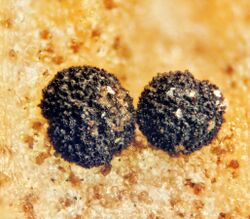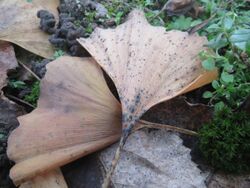Biology:Bartheletia
| Bartheletia | |
|---|---|

| |
| Closeup view | |

| |
| Macroscopic view | |
| Scientific classification | |
| Domain: | Eukaryota |
| Kingdom: | Fungi |
| Division: | Basidiomycota |
| Subdivision: | Agaricomycotina |
| Class: | Bartheletiomycetes Thines 2017[3] |
| Order: | Bartheletiales Thines 2017 |
| Family: | Bartheletiaceae R. Bauer, Scheuer, M. Lutz & Grube 2008 |
| Genus: | Bartheletia G.Arnaud ex Scheuer, R.Bauer, M.Lutz, Stabenth., Melnik & Grube 2008 |
| Species: | B. paradoxa
|
| Binomial name | |
| Bartheletia paradoxa | |
Bartheletia paradoxa is a species of dimorphic fungus and is the only member of the genus Bartheletia. Bartheletia is the only genus in the family Bartheletiaceae, which is the only family in Bartheletiales, which in turn is the only order in the class Bartheletiomycetes.[4][5]
Sorus-like sporodochia form on freshly fallen leaves and petioles of Ginkgo biloba in early autumn in Asia and Europe and persist through the winter. They produce slimy, hyaline 1-celled, cylindrical conidia. Thick-walled, dark brown teliospores develop in leaf tissue, clustered in structures ~1 mm diam, similar to telia of rust fungi, causing black leaf spots surrounded by a gray halo. After a year of dormancy, long-stalked basidia emerge through an apical channel from each teliospore, becoming round, cruciately-septate, and producing a succession of cylindrical basidiospores from four wart-like loci.[2]
Cultures can be isolated from discharged basidiospores or conidia spread on standard agar media.[2]
Like its host G. biloba, B. paradoxa has no closely related (living) relatives and is considered a "living fossil".[2]
References
- ↑ G. Arnaud, Bulletin de la Société Mycologique de France 69: 300 (1954)
- ↑ Jump up to: 2.0 2.1 2.2 2.3 Scheuer, C.; Bauer, R.; Lutz, M.; Stabentheiner, E.; Mel'nik, V.A.; Grube, M. 2008. Bartheletia paradoxa is a living fossil on Ginkgo leaf litter with a unique septal structure in the Basidiomycota. Mycological Research. 112(11):1265-1279
- ↑ Mishra, B; Choi, YJ; Thines, M. 2017. Phylogenomics of Bartheletia paradoxa reveals its basal position in Agaricomycotina and that the early evolutionary history of basidiomycetes was rapid and probably not strictly bifurcating. Mycological Progress. 17(3):333-341
- ↑ "Bartheletiomycetes". https://www.uniprot.org/taxonomy/2231722.
- ↑ "Taxonomy Browser". https://www.ncbi.nlm.nih.gov/Taxonomy/Browser/wwwtax.cgi?id=2231722.
Wikidata ☰ Q4162157 entry
 |

